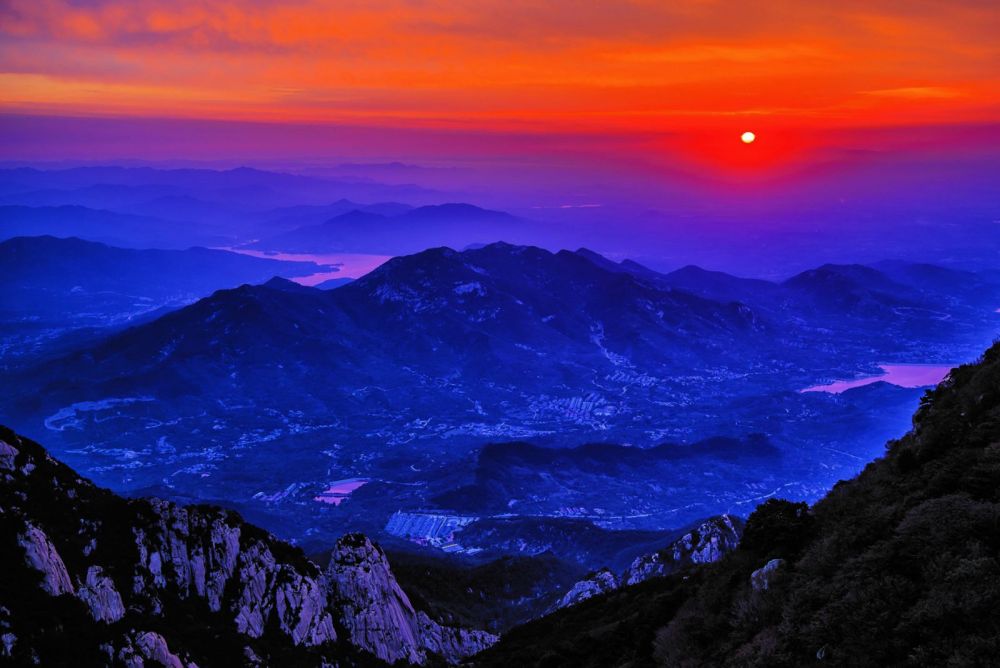Chinese Name: 泰山 Pronunciation: Tài Shān
Suggested Visiting Hours: 6-8 Hours
Height: 1,545 meters (5068.9 feet)
Mountain Area: 242 square kilometers
Address: Hongmen Road, Taishan District, Tai’an City, Shandong Province, China.
| Tickets | Discount Price | Content |
|
Joint Ticket: 115 yuan |
57 yuan (Minors between 6 and 18 years old can enjoy the discount) |
Mount Taishan+ Dai Temple +Red Gate Palace+ Heavenly Queen Pool+ Jade Spring Temple+ Puzhao Temple+ Color Stone River |
| Independent Dai Temple Ticket: 20 yuan | 10 yuan for students with Student Card | Dai Temple |
1.People with disabilities and senior citizens over 60 years old (including) are free of charge.
2.Members of China and Shandong Photographers Association and reporters are free of charge.
3.Children under 6 years old (including) or below 1.4 meters (including) are free of charge.
4.High-level talents with Shandong Huicai Card or Taishan Talent Gold Card are free of charge.
5.Before 8:00 a.m. on March 20, 2021, the national medical workers with valid certificates( include ID card, Hong Kong and Macao pass, Taiwan compatriot card, doctor’s license and nurse's license issued by competent health administrations) are free of charge.
| Contents | Price | Opening Hours |
| Sightseeing Bus (Tianwai Village→Halfway Gate to Heaven) |
30 yuan/person (one-way) | All day |
| Sightseeing Bus (Peach Blossom Ravine→Taohuayuan) |
30 yuan/person (one-way) | 7:00-17:00 |
| Sightseeing Bus ( Tai’an Railway Station→Halfway Gate to Heaven) |
35 yuan/person (one-way) | No information |
| Sightseeing Bus (Tai’an Municipal Government East Ecological Parking Lot→Halfway Gate to Heaven) | 32 yuan/person (one-way) | No information |
| Halfway Gate to Heaven Cable Car | 100 yuan/person (one-way) Children above 1.2 meters should buy a full ticket. |
April 1st ~ October 31st: Monday to Friday: 6:30 ~ 17:30 Weekend: 6:00 ~ 17:30 November 1st ~ March 31st: 8:00 ~ 17:00 |
| Taohuayuan Cable Car | 100 yuan/person (one-way) Children above 1.2 meters should buy a full ticket. |
April 1st ~ October 31st: Monday to Friday: 7:00 ~ 17:30 Weekend: 6:30 ~ 17:30 November 1st ~ March 31st: 8:00 ~ 17:00 |
| Houshiwu Cable Car | 20 yuan/person (one-way) Children above 1.2 meters should buy a full ticket. |
April 1st ~ October 31st: 8:30 ~ 16:00 November 1st ~ March 31st: not available |
| Note: Transportation facilities above are voluntary consumption. | ||
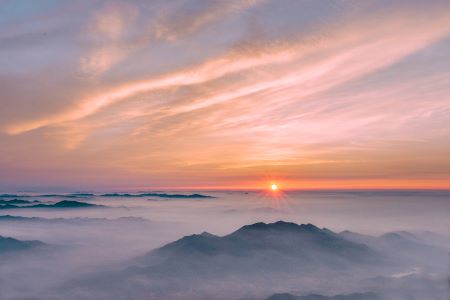
Mount Taishan, as the leader of the Five Mountains of China, is located in the middle part of Shandong Province, stretching across three cities: Tai’an, Jinan and Zibo. It was regarded as “the Heaven of Acquiring the Throne” and became a sacred mountain worshipped by the civilians and emperors in ancient times.
The sentence that "If Mount Taishan is stable, so is the whole country" is very popular in China. Safety is one of the core elements of Mount Taishan culture. In all beliefs, the most common and devout one in Mount Taishan is the belief of safety.
From the reign of the first emperor of the Qin Dynasty to the last emperor of the Qing Dynasty, 13 generations of emperors successively ascended Mount Taishan to pray to heaven and earth on mountain-top or make sacrifices because they thought their country can be governed well in this way. Therefore, the sacred status of Mount Taishan was raised to an unprecedented level at that time.
Mount Taishan is located on the north side of downtown area of Tai’an City. On a sunny day, the main peak of Mount Taishan, Jade Emperor Peak, can be seen clearly. Tourists can enter Mount Taishan scenic spot from four entrances. They are the entrance of Red Gate Palace, Tianwaicun (Heaven an d Earth Square), Peach Blossom Ravine and Tianzhu Peak.
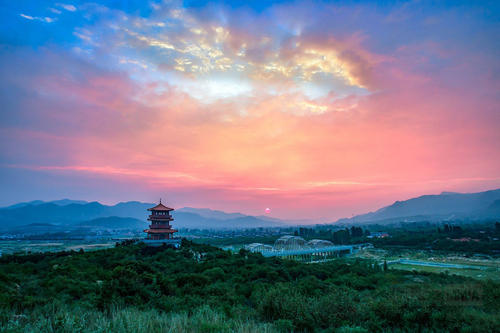
The mountain was once called Daishan or Daizong and was renamed Mount Taishan in the Spring and Autumn Period. Up to now, there are more than 20 ancient buildings and more than 2200 stone tablets and stone inscriptions on the mountain. Mount Taishan is the symbol of the Chinese nation, the epitome of oriental culture and the home of national spirit.
Representative attractions in this scenic spot include Dai Temple, Bixia Temple, Tianzhu Peak, etc. With magnificent scenery, Mount Taishan has attracted many celebrities who have drawn their inspiration from nature and created thousands of well-known poems. The poem “Gazing on Mount Taishan ” written by Du Fu (a famous poet in ancient China) is a typical work describing the beautiful scenery of Mount Taishan.
The typical natural environment and long history and culture of Mount Taishan have bred various beautiful mountains and waters and cultural resources, which vividly recorded the history of the Chinese nation. Due to the sacrifices offered by ancient emperors, Mount Taishan has become an important place for all kinds of religious sects to hold activities.
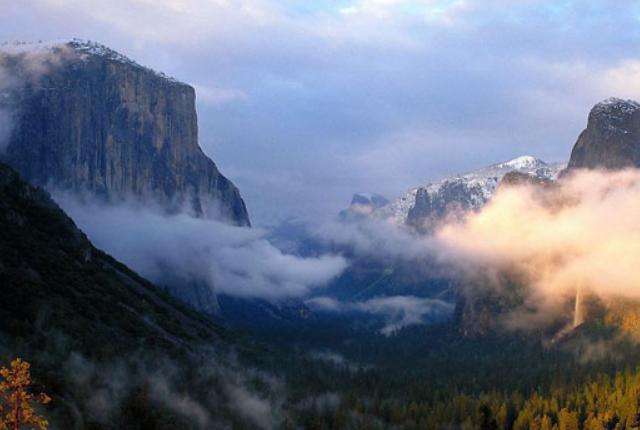
As the most popular tourist attraction in Shandong Province, Mount Taishan has a long history of religion. Buddhism, one of the three major religions in the world, was introduced into the area of Mount Taishan in the middle of the 4th century.
There are four optional routes to reach the top of the Mount Taishan, namely, East Route, West Route, Peach Blossom Ravine Route and Tianzhu Peak Route. The East Route is the most popular route among them because it is considered to be the imperial route that emperors all took to climb the mountain. Because the scenery of this route is deep and serene, it is also known as the "secluded area" of Mount Taishan.
Concerning the towering and majestic natural landscape and countless historic relics, Mount Taishan has become a rare tourist attraction combining history, culture and nature in the world. On December 12, 1987, Mount Taishan was listed as the World Cultural and Natural Heritage by UNESCO. On March 7, 2007, it was rated as the state 5A-class tourist attraction.
In the Sui Dynasty in 613, Zhang Xutuo defeated the insurrectionary army led by Wang Bo at the foot of Mount Taishan.
In the Tang Dynasty in 884, the leader of the peasant uprising, Huang Chao, was defeated in the mountain range of Mount Taishan, Langhu Valley.
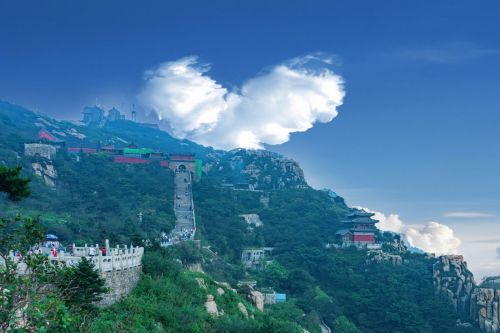
Jade Emperor Peak, located on the north side of Bixia Temple, is the summit of Mount Taishan and is 153 meters above sea level. It was known as Taiping Peak or Tianzhu Peak formerly.
The Jade Emperor Temple is located on the top of the Jade Emperor Peak, known as Taiqing Palace in ancient times. The temple was rebuilt during the Ming Dynasty, although there was no detailed research that elaborates the specific date of construction of the Jade Emperor Temple.
The main buildings in the scenic spot include Jade Emperor Hall, Yingxu Pavilion, Wanghe Pavilion, East and West Side Hall, etc. Inside the hall, there is a bronze figure of the Jade Emperor. In front of the hall, there is a Jiding Stone, marking the highest point of Mount Taishan. In the northwest of the stone, there is an inscription of "Ancient Dengfeng Platform", which indicates that this is the place where ancient emperors ascended the platform to offer a sacrifice to Heaven.
The Sun View Pavilion is located on the east side of Jade Emperor Peak, which is a perfect place for tourists to enjoy the sunrise. On the west side of Jade Emperor Peak, there is a River Enjoyment Pavilion. It provides tourists with beautiful scenery of sunset clouds and the golden belt of the Yellow River.
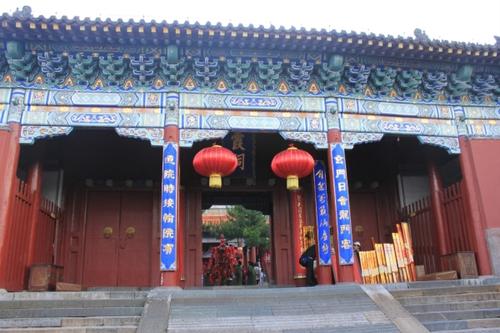
Bixia Temple, located on the south side of Jade Emperor Peak, is the heavenly residence of the Goddess, Yuanjun. It was built in 1009 during the Song Dynasty and was formerly called Zhaozhen Temple. The whole group of buildings of Bixia Temple are towering and magnificent. Viewed from a distance, the temple is surrounded by clouds, like a imperial palace in the sky.
The temple is made up of two courtyards. The main hall of Bixia Temple houses a gilded bronze sculpture of Yuanjun. Yuanjun, commonly known as the Mother of Mount Taishan, is also the Goddess of Mount Taishan. It is said that she is the daughter of the God of Mountain and will bring good luck to people. Therefore, there are a continuous stream of visitors going to Mount Taishan to worship Yuanjun every year.
As one of the key Taoist temples in China, Bixia Temple is composed of twelve pieces of distinctive buildings. The top of the main hall of Bixia Temple is made of 360 pieces of copper tiles, and there are three side halls on both sides of the temple respectively. The tiles on the top of the side hall are made of iron so as to avoid being corroded by rain or damaged by gale. Due to its scale and unique materials, Bixia Temple is a masterpiece among all structures at the top of Mount Taishan.
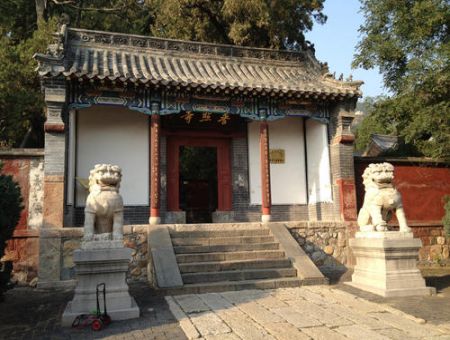
Dai Temple, built in the Han Dynasty, is the place where ancient emperors offered sacrifices to gods or ancestors. With a total area of about 100,000 square meters, it is the largest and best-preserved ancient building complex in Mount Taishan. In 1988, it was declared as a national key cultural relic protection unit by China State Council.
The main building, Tianfu Hall, was founded in the Song Dynasty. It was built with the highest standard of ancient Chinese architecture. It is one of the three palace buildings in ancient China. The large-scale mural in the hall, God of Mount Taishan Returning to the Palace, is one of the best Taoist frescoes in China with great historical and artistic value.
There are many steles and stone inscriptions in Dai Temple. Total 211 stone inscriptions were built in different dynasties since the Qin and Han Dynasties, which made Dai Temple got the title of " Stele Forest". There are more than 200 ancient and famous trees in Dai Temple, among which "Hanbai" and "Tanghuai" are the most famous trees.
Together with the Forbidden City in Beijing, the "Three Kong" (Confucius Temple, the Cemetery of Confucius and Kong Family’s Mansion) in Qufu and the Chengde Summer Palace in Hebei Province, the Dai Temple is regarded as the fourth representative buildings in ancient China. It is the epitome of history and culture of Mount Taishan with important historical, artistic and scientific values.
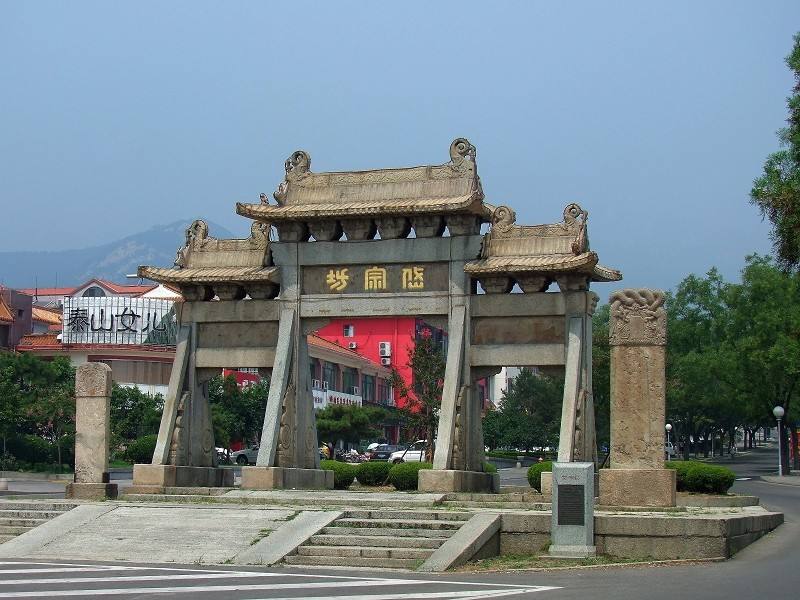
Dai Zong Archway is located in the south end of Hongmen Road and on the north side of Daizong street, which is the starting point of climbing Mount Taishan. It was built in Longqing period of Ming Dynasty and rebuilt in 1730. It is a stone archway with four columns and three gates. The construction shape is not only terse and decent but also refined and elegant.
The three gold Chinese characters"岱宗坊" (Dai Zong Archway) on the plaque have the function of guiding. There are two steles in front of the archway and the contents of the steles are respectively “The Renovation of Dai Zong Archway” and “The Renovation of Mount Taishan”.
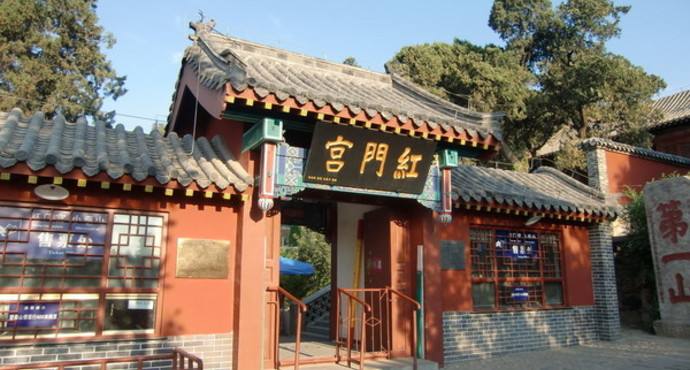
The Red Gate Palace is located in the north of the stone archway, Confucius Climbed Point. It faces Zhongxi to the east and Dazang Ridge to the west. It was rebuilt in 1626 although there was no detailed study on the date of construction of Red Gate Palace. It is divided into east and west courtyards and connected by Feiyun Pavilion. The arched door is inscribed with the Chinese characters "红门". The west courtyard is a Taoist temple, and its gate is inscribed with "红门宫" (Red Gate Palace), which is used to worship the goddess of Mount Taishan, Yuanjun. The east courtyard is the "Maitreya hall", which is used to worship Maitreya Buddha.
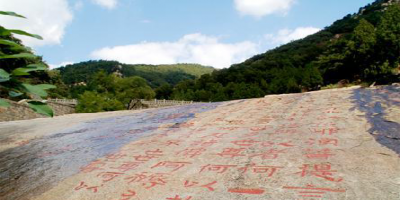
Jing Shi Valley is located in the northeast of Doumu Palace in Mount Taishan. There are many branch roads and bends connected with each other. After passing through Shuyu Bridge, High Mountains and Flowing Water Pavilion and Shenlin Bridge, you can reach Jing Shi Valley. There are gentle slopes and stones in the valley, on which are engraved with Diamond Sutra written in official script. This kind of stone is commonly known as the Sutra Drying Stone.
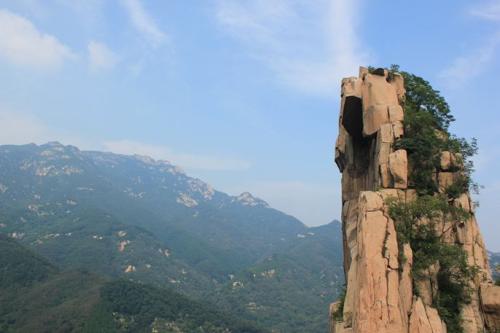
The Eighteen Bends is the most dangerous part on the way to top of Mount Taishan. There are more than 1600 stone steps, which is one of the major symbols of Mount Taishan. The steep bends between the cliffs are just like the scaling ladders leading to the gate of heaven from a distance.
The stratum of eighteen bends is steep with a dip angle of 70 to 80 degrees. It is said that there are three "Eighteen Bends" in Mount Taishan. From Kaishan to Longmen, it is "Slow Eighteen Bends", and then to Shengxian Archway, it is "Steady Eighteen Bends", and to South Gate to Heaven, it is "Quick Eighteen Bends". In total, there are more than 1630 steps.
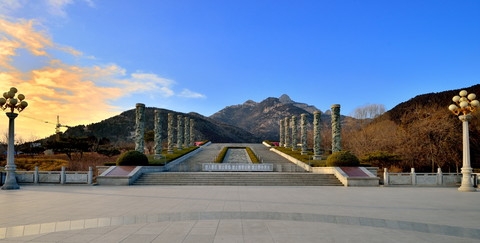
Heaven and Earth Square is also named Tianwai Village Square, which is an ingenious transition between the city and the mountain. It was built in accordance with the ancient concept of "the sky is round and the earth is square" and the people's psychology of "harmony between heaven and earth".
The square covers a total area of 35,000 square meters. It mainly includes square square(the side length of square square is 36 meters with an area of more than 1,000 square meters) and round square (the diameter of round square is 108 meters with an area of more than 10000 square meters).
On both sides of the connecting passage of the two squares, 12 dragon pillars with a height of 7.2 meters and a diameter of 0.9 meters are placed, indicating that there were 12 emperors once making sacrifices at Mount Taishan from the first emperor of Qin Dynasty to Emperor Qianlong in Qing Dynasty. The balustrades around the square one are engraved with famous remarks about Mount Taishan.
The round square is equipped with six ticket offices and access control system in order to implement intelligent ticket checking and orderly riding. The inner ring of the square is the carriageway, which can park 12 tourist buses at the same time. These tourists buses can carry more than 8,000 tourists an hour, which can meet the needs of tourists in peak season.
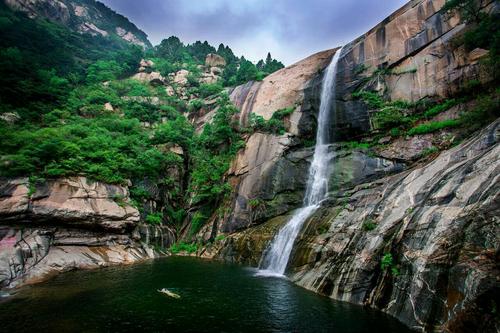
On the Baizhang Cliff of Xixi (a place in Mount Taishan), there is a waterfall cascades down the cliff. The sound of flowing waterfall is like thunder and the shape of waterfall is like thousand feet silver chains. The waterfall pours all year around, forming a pool under the cliff. It is said that there are dragons come and go in the pool, so it is called Black Dragon Pool, which is connected with the Dragon Palace of the Eastern Sea.
Miao Runfu, a scholar in the Qing Dynasty, once wrote a poem to describe the magnificent scenery of the pool. "Dragon Pool Waterfall" is one of the famous scenic spots in the Xixi of Mount Taishan. When you make the trip to the waterfall and read poetry about it, you will go over endlessly in your thought.
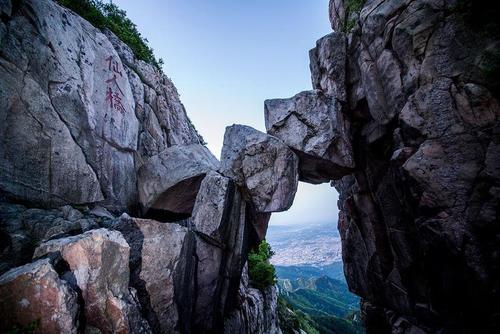
Above the Black Dragon Pool, there is a bridge connecting the east and the west. It looks like a rainbow in the mountain stream, which attracts many tourists to visit the pool and the bridge. The vermillion bridge and the green hills on both sides of the river present a lovely scene. People can enjoy the beautiful scenery of Black Dragon Pool on the bridge. The name of this bridge is Longevity Bridge.
Longevity Bridge was built in 1924 by Zhang Peirong, an official of Yanzhou at that time. His wife heard that Mount Taishan has beautiful scenery, where many people impetrated eternity there. In order to have an eternal life, she asked her husband to build a temple in Mount Taishan.
The temple is located on the west side of the stream, which is inconvenient for her wife to cross the river when up and down the mountain. Therefore, Zhang Peirong built a long bridge on Baizhang Cliff for the purpose of pleasing Mrs. Zhang and named the bridge Longevity Bridge.
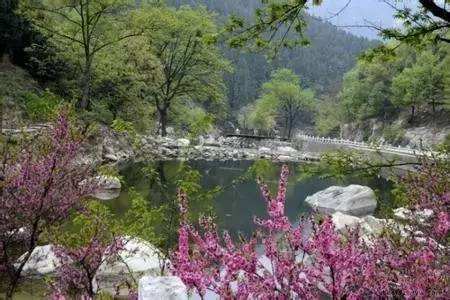
Peach Blossom Ravine is located on the west side of Mount Taishan with a length of 10.5 km. In this secluded scenic spot, you can hear the gurgling stream and sweet and agreeable birdsong. With abundant water, luxuriant flowers and trees, the scenery here is very charming.
The most famous fish in Peach Blossom Ravine is Mount Taishan Red Squama Fish. They can be found between the cracks in the stone with nimble and light bodies. The clear and deep water here has the highest oxygen content, less minerals and low hardness, which has become the breeding place for Mount Taishan Red Squama Fish. The vegetation is luxuriant in this ravine, and the trees are mainly Chinese pines.
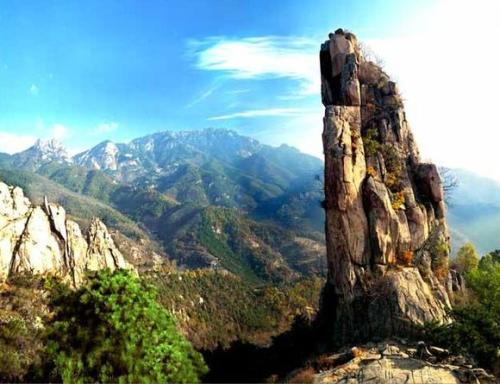
Tianzhu Peak is located on the northeast side of Mount Taishan. There is a winding road leading to the summit of Mount Taishan.
The entrance to Mount Taishan of this climbing route is about 20 kilometers away from Taishan Railway Station. The view in Tianzhu Peak represents the ultimate natural landscape of Mount Taishan. The whole scenic area is like a giant bonsai, which is the unique scenery of Mount Taishan. The beautiful scenery is comparable to Mount Huang.
Most of the area in this travel route is covered with Pinus Armandi. Even in winter, the scenery here is just like that of spring. It is a place full of vitality and makes people have a feeling of pleasure. Especially the ancient pine garden close to the top of the mountain is unforgettable.
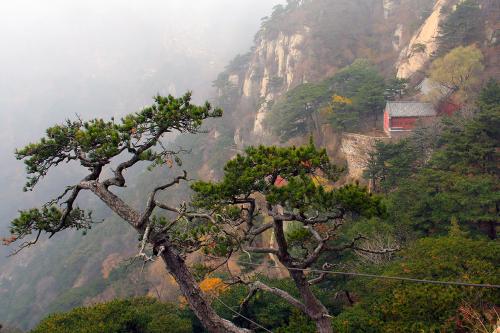
After passing through the North Gate to Heaven, there is a fork in the road. At this time, you can reach Hou Shi Wu by walking 900 steps eastward. Hou Shi Wu(后石坞) used to be called "后石屋", and it was also called "后十五" in the early days because it was said that this place was 7.5 kilometers (15 li, 1 li equals to 500 meters) away from Jade Emperor Peak. In fact, the straight-line distance between Jade Emperor Peak and Hou Shi Wu is only about 1.5 kilometers. In ancient times, the mountain road was too winding to walk, which made people feel that the road was very long.
Hou Shi Wu has been known as "The First Blessed Spot in Jade Emperor Peak " since ancient times. It has steep cliffs, ancient pines, stone inscriptions and ancient temples. The scenery of Hou Shi Wu is quite different from that of Dengtian Scenic Area and Jade Emperor Peak. It is known as the "Back Garden" of Mount Taishan. The main scenic spots include Jiu Long Gang, Yao Guan Ding, Sister Pine and Yuanjun Temple, etc.
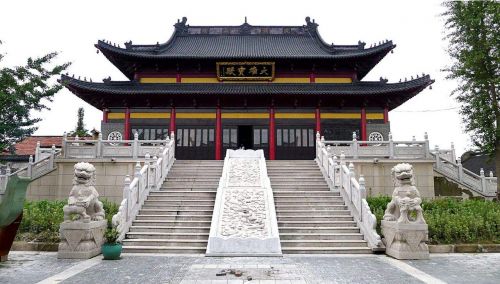
Located at the entrance of Peach Blossom Ravine, Yuanjun Temple is the west temporary palace of the Goddess of Mount Taishan. It is the only temple which faces to the west in Mount Taishan.
Inside the main hall of Yuanjun Temple, here is the Goddess of Mount Taishan, Bixia Yuanjun, who is the main goddess that enshrined in Mount Taishan and she is also called Taishan grandma by people. Every year on March 15 of the lunar calendar is Bixia Yuanjun’s birthday, there is an endless stream of men and women who come to Mount Tai to worship Bixia Yuanjun.
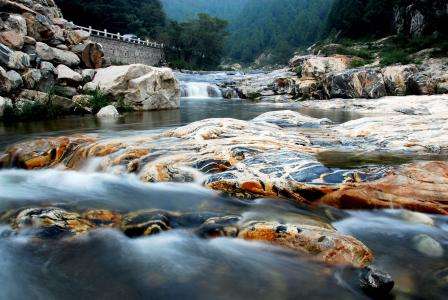
After entering Peach Blossom Ravine scenic spot, you can walk 2 kilometers to reach Cai Shi Stream. The bottom of the river is paved with colored stones, which is especially beautiful under the sunshine. The winding stream seems to be colored by multi-colored stones, attracting a number of tourists to visit. The stream is also like a colorful ribbon, fluttering with the wind.
If you are attentive enough, you can see the Mount Taishan Red Scale Fish in the water. According to the investigation and analysis of geologists, the category of stones in Cai Shi Stream is striped plagioclase amphibolite. The light white stripe and dark green plagioclase amphibolite constitute the colorful river bedrock, which is very spectacular and beautiful.
Through the refraction of water, the colorful stone patterns have changed into various shapes and colors. Some of stone patterns are like ethereal fairies or meditative elders, meditating on why nature has given Mount Taishan such a magnificent scenery.
1. Middle Route:
The Middle Route is the most classical climbing route that integrates cultural landscape and natural landscape of Mount Taishan, providing tourists with a comprehensive landscape of the mountain. There are more than 7000 bends along the route and the whole course of the route is about 9.5 km.
Dai Temple/ Daizong Archway → Confucius Climbed Point → Red Gate Palace → Wanxian Building( ticket office) → Doumu Palace → Jingshi Valley →Huimable Range → Hutian Pavilion → Halfway Gate to Heaven → Yunbu Bridge → Wudafu Pine → Welcoming Pine Tree → Pine-Opposing Hill → The Eighteen Bends → South Gate to Heaven → Heaven Street → Bixia Temple → Daguan Peak → Jade Emperor Peak
2. West Route:
The West Route is the most convenient, time-saving and labor-saving route to climb the mountain, which is suitable for people with poor physical strength or insufficient time. If you choose this route to go up the mountain, you may be glad that you have avoided an arduous process of climbing. A sweaty process can be changed into a relaxed one with the help of convenient vehicle by taking the West Route.
Tianwaicun → Tianwaicun Square →Dazhong Bridge → Puzhao Temple → Wuxian Temple →Black Dragon Pool Waterfall → Bamboo Temple → Huangxi River → Fan Cliff → Aolaifeng → Halfway Gate to Heaven → Ropeway → South Gate to Heaven → Bixia Temple → Jade Emperor Peak
* Although taking this route is convenient for you to reach the top, you will miss many scenic spots at the same time. Therefore, after arriving at Halfway Gate to Heaven, the traditional climbing route- Middle Route is recommended to tourists to get to the top of the mountain.
3. Peach Blossom Ravine Route:
The Peach Blossom Ravine Route, located on the west side of Mount Taishan, is the most romantic route. In spring, peach blossom blooms all over the mountains and plains. The mountaineering position of this route is far away from the center of the city, which is suitable for self-driving tour. Self-guided tourists are not recommended to take this route for climbing.
Peach Blossom Ravine → Diaoyutai → Bifeng Temple → Cai Shi Stream → Chilin Stream → Hongyuchuan → Taohuayuan
* You can take the cable car in Taohuayuan Stop to reach the top in a few minutes.
4. Tianzhu Peak Route:
The Tianzhu Peak Route is the most primitive and natural climbing route of Mount Taishan. It is also the route with the most concentrated and beautiful natural landscape. Its name(天烛峰) can be traced back to a pine tree, which is at the top of Tianzhu Peak and looks like the flame of a candle in the distance.
Steep peaks, deep valleys, strange pines and rocks are not rare here. Mountain springs, streams and waterfalls can be seen everywhere. Except for the climbing bends, most places are not man-made but natural. This route is also known as the "Ten Mile Gallery" of Mount Taishan, which is the best choice for adventurous tourists or independent travelers.
Tianzhufeng → Yuanjun Temple → Sister pine →Small Tianzhu Peak → Niangniang Temple → Sun-viewing Peak →Jade Emperor Peak
* Tourists who took the Middle Route to go up the mountain in the past can choose the Tianzhu Peak Route so as to enjoy more beautiful scenery of Mount Taishan.
The climate at the foot and top of the Mount Taishan is quite different. In January, the average temperature at the foot of the mountain is -3℃, while at the top of the mountain is -9℃. In July, the average temperature at the foot of the mountain is 26℃, while at the top of the mountain is 18℃.
The best time to visit Mount Taishan is from May to November every year. In other words, it is suitable for tourists to visit Mount Taishan in spring, summer and autumn. There are four wonders here: sunrise of Mount Taishan, the sea of clouds, sunset and the Yellow River glitters like a golden ribbon.
1. Taishan Railway Station → Mount Taishan(Hongmen/Tianwai Village)
Take the direct tourist bus from the railway station to Hongmen or Tianwai Village. Hongmen is the starting point of the climbing route, while Tianwai Village is the place where to take a sightseeing bus to Halfway Gate to Heaven (Zhongtianmen).
Take bus 3, 37 or 39 (North Ring Line) to Hongmen or Tianwai Village.
2. Tai’an Railway Station → Mount Taishan(Tianwai Village)
Take bus 37 or 68 to Tianwai Village.
3. Tai’an City → Mount Taishan( Hongmen/Tianwai Village )
Take bus 3, 37 or 39 (North Ring Line) to Hongmen or Tianwai Village.
Chinese: 请带我去泰山。 English: Please take me to the Mount Taishan.
If you go to the Mount Taishan by taxi, it takes about 20minutes and 25 yuan from Tai’an City downtown area to the scenic spot, and about 90 minutes and 300 yuan when coming from the Jinan Yaoqiang International Airport.
